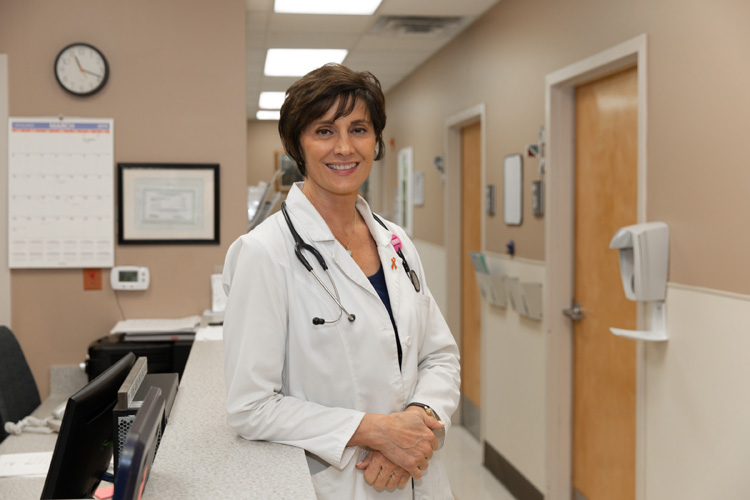
Is HBO right for everyone with a diabetic foot wound?
If the HBO in question is hyperbaric oxygen therapy, that’s a trickier question than you might think.
According to the Mayo Clinic, “hyperbaric oxygen therapy involves breathing pure oxygen in a pressurized room or tube. Hyperbaric oxygen therapy is a well-established treatment for decompression sickness, a hazard of scuba diving.”
Other conditions treated with HBO therapy “include serious infections, bubbles of air in your blood vessels and wounds that won’t heal as a result of diabetes or radiation injury.”
Dr. Michele Maholtz at the Cleveland Clinic Indian River Hospital wound healing and hyperbaric medicine center agrees with Mayo Clinic: “It speeds healing. I think, from a clinical perspective, we definitely see people heal faster.”
In addition to diabetic wounds, Maholtz says, “we have people who’ve had, say, breast cancer. They’ve been radiated and they’ve had surgery. They have a wound that won’t heal because that area was radiated, [which] damaged the blood flow to the area.”
She contends HBO helps those patients and adds, “we’ve treated a couple of men who’ve had radiation for bladder cancer and then they get hematuria (blood in the urine) and we have them in the [HBO] chamber for those kinds of things.”
However, the U.S. National Library of Medicine at the National Institutes of Health is not convinced that oxygen is effective for the treatment diabetic wounds.
It says “the evidence makes it difficult to draw any definitive conclusions on the clinical and cost effectiveness of standard wound care plus HBO versus standard wound care alone for the treatment of diabetic foot ulcers.”
Likewise, the American Diabetes Association refuses to endorse HBO for diabetic foot wounds.
It says there is “not enough supporting data on the efficacy of this treatment to recommend its use.”
Nevertheless, many doctors believe in the treatment and serious complications from the therapy are relatively rare. For those reasons, HBO is a moneymaker for hospitals and treatment centers.
As the Washington Post reports, “hyperbaric treatment, increasingly given to diabetics – many of them elderly and with persistent wounds – involves breathing pure oxygen inside a pressurized air chamber. Sessions typically last two hours each weekday, often for more than a month, and 20 outpatient visits can bring a hospital $9,000 in revenue.”
Using the Post’s numbers, the 1,200 patients treated annually with HBO at the Cleveland Clinic Indian River Hospital’s wound center could generate more than $10 million in revenue, though it’s unlikely all 1,200 would rack up 20 two-hour visits.
“Enticed by healthy Medicare payments – about $450 for a two-hour session – some 1,300 U.S. hospitals have now installed hyperbaric facilities,” according to the Post.
The actual mechanics of hyperbaric oxygen therapy are relatively easy to grasp.
With the patient inside, the chambers create between two to two-and-a-half times the normal atmospheric pressure using 100 percent oxygen.
The air we breathe at home, in the car or out on the golf course is only about 21 percent oxygen. Nitrogen makes up a whopping 78 percent of the rest along with minuscule portions of argon, methane and carbon dioxide.
In other words, patients breathing inside a hyperbaric oxygen chamber can get many times the amount of oxygen into their lungs and bloodstream than would be possible outside of one and since it has been clinically shown that, as Johns Hopkins says, “wounds need oxygen to heal properly,” the current prevailing assumption is that HBO does help to heal a wide variety of wounds and burns.
The most ringing endorsement of HBO actually comes from Canada.
An Ontario Health technology assessment based on seven randomized trials and one nonrandomized controlled trial, found “mixed results” as far as amputation rates for diabetic patients undergoing HBO but it also claims the treatments resulted in “better outcomes than standard wound care alone,” and perhaps more importantly, “patients feel that HBO is an effective treatment and report that they were satisfied with how their ulcers healed and that this improved their quality of life.”
As long as patients in the U.S. remain satisfied and Medicare continues to help foot the bill, HBO will likely remain in use as an essential tool in the diabetic wound care toolbox.
Dr. Michele Maholtz is board certified in pulmonary medicine, critical care and sleep disorders. She is at the Cleveland Clinic Indian River Hospital’s ambulatory care office one-half day a week. She also has offices at 3725 12th Court, Suite A in Vero Beach. That phone number there is 772-567-0081.




Comments